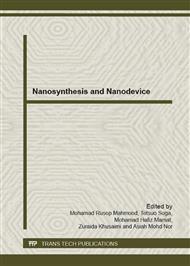[1]
A. Uhlir, Electrolytic shaping of germanium and silicon, The Bell System Technical Journal. 35 (1956) 333-347.
DOI: 10.1002/j.1538-7305.1956.tb02385.x
Google Scholar
[2]
S. A. Nepijko, D. N. Ievlev, D. B. Dan'ko, R. D. Fedorovich, W. Schulze, G. Ertl, Electroluminescence spectra of porous silicon as a function of the applied voltage, Physica B: Condensed Matter. 299 (2001) 32-35.
DOI: 10.1016/s0921-4526(00)00766-3
Google Scholar
[3]
G. Bomchil, A. Halimaoui, I. Sagnes, P. A. Badoz, I. Berbezier, P. Perret, B. Lambert, G. Vincent, L. Garchery, J. L. Regolini, Porous silicon: material properties, visible photo- and electroluminescence, Applied Surface Science 65–66 (1993).
DOI: 10.1016/0169-4332(93)90692-5
Google Scholar
[4]
V. Paillard, P. Puech, M. A. Laguna, R. Carles, B. Kohn, F. Huisken, Improved one-phonon confinement model for an accurate size determination of silicon nanocrystals, Journal of Applied Physics Letters 86 (1999) 1921-(1924).
DOI: 10.1063/1.370988
Google Scholar
[5]
A. Bsiesy, J. C. Vial, Voltage-tunable photo- and electroluminescence of porous silicon, Journal of Luminescence. 70 (1996) 310-319.
DOI: 10.1016/0022-2313(96)00064-6
Google Scholar
[6]
D. A. Kim, J. H. Shim, N. H. Cho, PL and EL features of p-type porous silicon prepared by electrochemical anodic etching, Applied Surface Science 234 (2004) 256-261.
DOI: 10.1016/j.apsusc.2004.05.028
Google Scholar
[7]
D. F. Timokhov, F. P. Timokhov, Influence of injection level of charge carriers in nanostructured porous silicon on electroluminescence quantum efficiency, Microelectronic Engineering 81(2005) 288-292.
DOI: 10.1016/j.mee.2005.03.021
Google Scholar
[8]
F. Philippe M, Photoluminescence and electroluminescence from porous silicon, Journal of Luminescence 70 (1996) 294-309.
Google Scholar
[9]
E. Savir, J. Jedrzejewski, A. Many, Y. Goldstein, S. Z. Weisz, M. Gomez, L. F. Fonseca, O. Resto, Relation between electroluminescence and photoluminescence in porous silicon, Materials Science and Engineering: B 72 (2000) 138-141.
DOI: 10.1016/s0921-5107(99)00488-2
Google Scholar
[10]
M. A. Zubaidah, N. A. Asli, S. F. M. Yusop, M. Rusop, S. abdullah, Photoluminescence properties of porous silicon nanostructures (PSiNs) with optimum electrolyte volume ratio of photo-electrochemical anodization, Advanced Materials Research 620 (2013).
DOI: 10.4028/www.scientific.net/amr.620.40
Google Scholar
[11]
C. Meyer, H. Lorenz, K. Karrai, Electroluminescence from a current-emitting nanostructured silicon device, Superlattices and Microstructures 33 (2003) 339-346.
DOI: 10.1016/j.spmi.2004.02.008
Google Scholar


